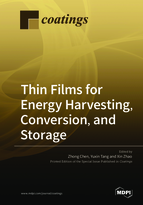Thin Films for Energy Harvesting, Conversion, and Storage
A special issue of Coatings (ISSN 2079-6412).
Deadline for manuscript submissions: closed (30 April 2019) | Viewed by 61164
Special Issue Editors
Interests: icephobic coatings; self-cleaning; self-healing; anti-bacteria; anti-fouling; photocatalytic; wear & friction-reduction
Interests: lithium-ion batteries; rational materials design; titanium-based anode materials; lithiation thermodynamic and kinetic; fast charging of batteries
Special Issue Information
Dear Colleagues,
The aim of this Special Issue is to provide a platform for research scientists and engineers in the areas of energy harvesting, conversion, and storage to demonstrate and exchange their latest research advances. This thematic topic undoubtedly represents an extremely important technological direction for the current century, and has already seen rapid development in the past decades. This Special Issue will cover materials processing, characterization, simulation, and performance evaluation of thin films used in:
- Photovoltaics;
- Thermoelectric generation;
- Photoelectrochemical/electrolytic hydrogen generation;
- Hydrocarbon production through CO2 reduction;
- Fuel cells;
- Supercapacitors;
- Flow batteries;
- Various types of rechargeable ion batteries.
Other sub-topics will also be considered as long as they align with the general theme of the Special Issue. Research work at both component and system levels is encouraged. Both original research articles and review articles are welcome.
Prof. Dr. Zhong Chen
Dr. Yuxin Tang
Dr. Xin Zhao
Guest Editors
Manuscript Submission Information
Manuscripts should be submitted online at www.mdpi.com by registering and logging in to this website. Once you are registered, click here to go to the submission form. Manuscripts can be submitted until the deadline. All submissions that pass pre-check are peer-reviewed. Accepted papers will be published continuously in the journal (as soon as accepted) and will be listed together on the special issue website. Research articles, review articles as well as short communications are invited. For planned papers, a title and short abstract (about 100 words) can be sent to the Editorial Office for announcement on this website.
Submitted manuscripts should not have been published previously, nor be under consideration for publication elsewhere (except conference proceedings papers). All manuscripts are thoroughly refereed through a single-blind peer-review process. A guide for authors and other relevant information for submission of manuscripts is available on the Instructions for Authors page. Coatings is an international peer-reviewed open access monthly journal published by MDPI.
Please visit the Instructions for Authors page before submitting a manuscript. The Article Processing Charge (APC) for publication in this open access journal is 2600 CHF (Swiss Francs). Submitted papers should be well formatted and use good English. Authors may use MDPI's English editing service prior to publication or during author revisions.







